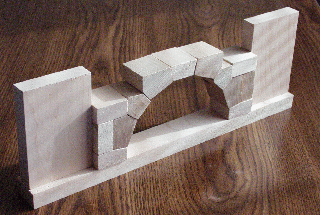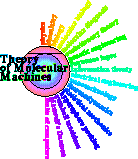The way science keeps returning to the straight and true
is by noting errors and by correcting them.
Michael Shermer
wrote an interesting article
in the October 2001 Scientific American (page 30) entitled
"I Was Wrong"
He says "Those three words often separate
the scientific pros from the posers".
One can always correct one's errors and change categories, so
posers
can turn into pros.
This page was written in response to critiques of the
Ev paper and program.
To drive the point home, it seems reasonable to list
known errata and corrigenda for our own papers.
Errata and corrigenda
are corrections to typographical errors that can either come from
the original text or are introduced by
typesetters when they retypeset a paper.
When a significant error was not caught until after publication,
it can be reported in a
correngium.
Obviously a deeper error is to publish
a hypothesis or theory and it is later shown to be wrong.
Of course there is nothing bad about that,
it's the way science works.
But it is nice to make a correct hypothesis
or theory once in a while, and someone who
consistently fails to do so probably won't
last long in science unless they make really fruitful
bad hypotheses!
Some people
make hypotheses
and then stick with them in the face of counter evidence.
 An example is the hypothesis of Behe, who
proposed
in his book
"Darwin's Black Box"
that there are biological structures
too complex to be evolved.
The
ev paper demonstrates a case that fits his
criteria exactly but is indeed evolved.
So his thesis failed, though he has yet to admit it
as of this writing (2002 June 6 to 2004 September 29).
However, from this demolished idea comes the idea
that there are
Roman arch-like structures in biology.
According to Behe they could not exist since
removal of any one stone would destroy the whole.
Yet they do exist and are actually quite common
in biology. A really simple direct example is
an animal walking around on legs. Remove any one joint
and it could not walk! How did it come to the arch
of its body above gravity?
It is pretty clear that one slithers along the ground
first!
This is an example of a dead hypothesis that
leads to some interesting biology anyway.
An example is the hypothesis of Behe, who
proposed
in his book
"Darwin's Black Box"
that there are biological structures
too complex to be evolved.
The
ev paper demonstrates a case that fits his
criteria exactly but is indeed evolved.
So his thesis failed, though he has yet to admit it
as of this writing (2002 June 6 to 2004 September 29).
However, from this demolished idea comes the idea
that there are
Roman arch-like structures in biology.
According to Behe they could not exist since
removal of any one stone would destroy the whole.
Yet they do exist and are actually quite common
in biology. A really simple direct example is
an animal walking around on legs. Remove any one joint
and it could not walk! How did it come to the arch
of its body above gravity?
It is pretty clear that one slithers along the ground
first!
This is an example of a dead hypothesis that
leads to some interesting biology anyway.
Schneider Lab List of Errors and Corrections:
-
Erratum to an equation in the
1991
edmm paper.
-
Erratum to Figure 2 legend in the
1997
walker paper.
-
2002 June 9.
Erratum
for the
1998
rfs paper.
-
2002 January 18.
Erratum of a reference in the
2001
flexrbs paper.
-
2002 June 4.
Corrigendum to a figure in the
2001
repan3 paper.
-
2003 August 28.
Corrigendum to text in the
1996
malign paper.
2003 Sep 1:
John S. Garavelli reports that
there is a similar error
in Monod's Chance and Necessity.
This is a bit of text from John's
PhD thesis
@phdthesis{Garavelli75,
author = "John S. Garavelli",
title = "Part I. Studies on the Structure of Mitochondrial Malate
Dehydrogenase Part II. Applications of Information Theory to Protein
Structure",
year = 1975,
school = "Washington University",
address = "Saint Louis, MO",
type = "{Ph.~D.} dissertation",
note = "{\it Diss.\ Abstr.\ Int.\ B} {\bf 36} (1976), 4437-4438"}
which points out the correction in this text
and footnote:
"The globular shape peculiar to a given protein --- the special shape required
for its functional activity --- will therefore be in fact dictated by the
sequence of residues in the fiber. However, and this is the important point,
the quantity of information that would be needed to describe the entire
three-dimensional structure of a protein is far greater than the amount
of information defined by the sequence itself. For example, for a polypeptide
100 residues long the information (H) necessary to define the sequence would
come to about 2000 (sic) bits
(H=log2 20100), whereas to define
its three dimensional structure this sum of information would have to be
supplemented by a great deal more, the exact amount being difficult to
calculate."
Footnote: (The sequence information relative to conformation is, as
will be shown, in fact much less than
log2 20100 = 432.192 bits.)
(Monod, 1971, pp. 93-94)
Monod, J. (1971) Chance and Necessity, Alfred A. Knopf, Inc., New York.
(Reproduced with permission.)
Note: I would suggest not calling H the information, but
rather,
the uncertainty.
-
In a paper critiquing the
Ev program
I.G.D. Strachan
pointed out a bug in the ev code
(Appendix B, PDF - BUT www.iscid.org no longer exists as of 2016 Mar 17).
Michael Y. Levashov has confirmed the bug.
(The bug will be corrected when I have confirmed it for myself.)
See:
Evaluation of `An Evaluation of "Ev"'.
Notes
2003 May 8:
I found an interesting example in
Nature
(423 (1 May 2003) www.nature.com/nature p.21)
in "Life's transistors"
by Fred J. Sigworth:
Practically everyone in the ion-channel field
(including myself) has imagined
the S4 segment to be an alpha-helix ...
But the results of MacKinnon and colleagues
show that it is almost certainly wrong.
Scientists admit when they are wrong.
2005 May 30:
Even the mainstream media admits errors.
Newsweek dated today, we find
A Letter to Our Readers
which retracts a story they published.
... we got an important story wrong, and honor requires us to admit
our mistake and redouble our efforts to make sure that nothing
like this ever happens again.
...
when we make a mistake---as institutions and individuals inevitably
do---we will confront it, correct it quickly and learn from the
experience.
 An example is the hypothesis of Behe, who
proposed
in his book
"Darwin's Black Box"
that there are biological structures
too complex to be evolved.
The
ev paper demonstrates a case that fits his
criteria exactly but is indeed evolved.
So his thesis failed, though he has yet to admit it
as of this writing (2002 June 6 to 2004 September 29).
However, from this demolished idea comes the idea
that there are
Roman arch-like structures in biology.
According to Behe they could not exist since
removal of any one stone would destroy the whole.
Yet they do exist and are actually quite common
in biology. A really simple direct example is
an animal walking around on legs. Remove any one joint
and it could not walk! How did it come to the arch
of its body above gravity?
It is pretty clear that one slithers along the ground
first!
This is an example of a dead hypothesis that
leads to some interesting biology anyway.
An example is the hypothesis of Behe, who
proposed
in his book
"Darwin's Black Box"
that there are biological structures
too complex to be evolved.
The
ev paper demonstrates a case that fits his
criteria exactly but is indeed evolved.
So his thesis failed, though he has yet to admit it
as of this writing (2002 June 6 to 2004 September 29).
However, from this demolished idea comes the idea
that there are
Roman arch-like structures in biology.
According to Behe they could not exist since
removal of any one stone would destroy the whole.
Yet they do exist and are actually quite common
in biology. A really simple direct example is
an animal walking around on legs. Remove any one joint
and it could not walk! How did it come to the arch
of its body above gravity?
It is pretty clear that one slithers along the ground
first!
This is an example of a dead hypothesis that
leads to some interesting biology anyway.
